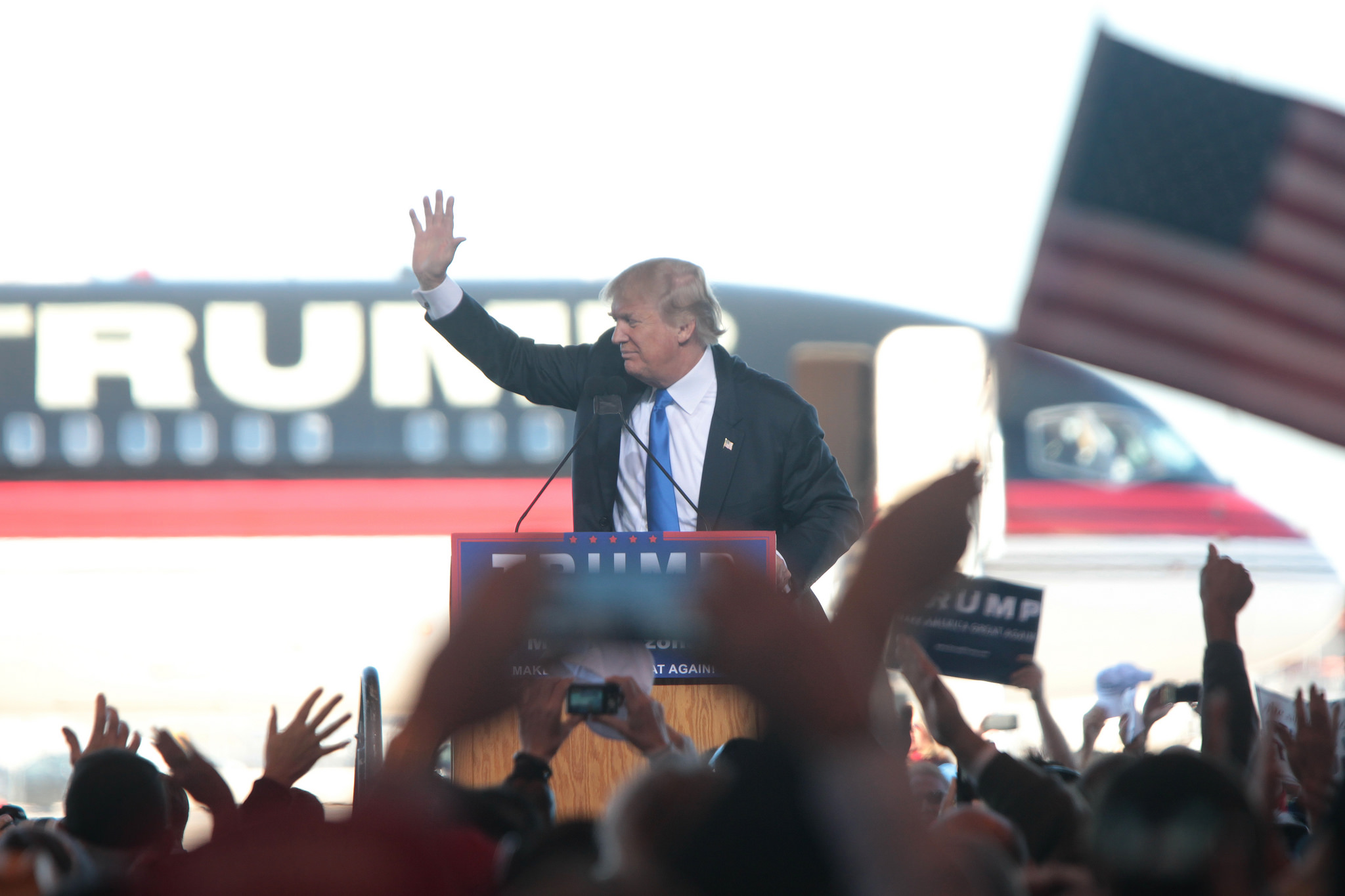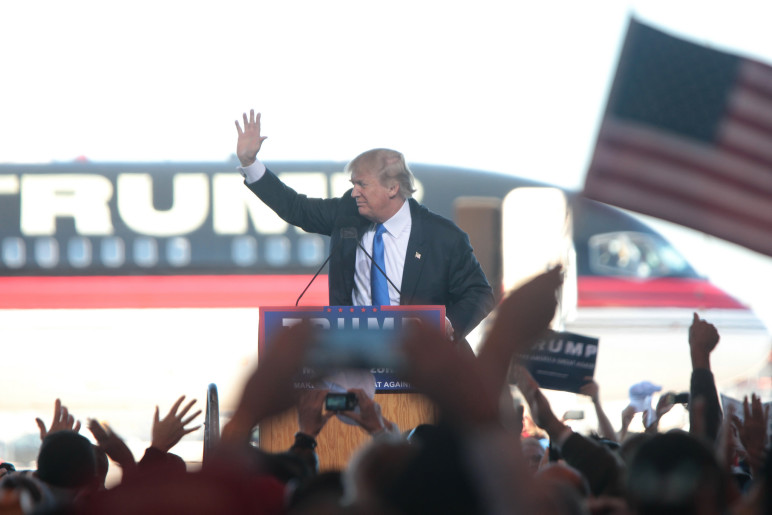This is an unusual election year in the United States, both in terms of the breadth of the Republican field and the strength of populist candidates in both parties. But some aspects are unfortunately extremely normal for the US’s two-party, plurality voting system:
- a candidate can win the party nomination even when most party primary voters support someone else;
- a tiny number of voters pick two candidates for the rest of us; and
- the cycle is plagued by negativity.
How Trump is winning, even though most Republicans aren’t voting for him
As of Super Tuesday, Trump is leading the Republican field with about one-third of the Republican vote. In other words, two-thirds of Republican primary voters want someone other than Trump. A super-majority of Republican voters so far have divided their votes amongst four other candidates, but whom would they choose if they could consolidate? What if Carson and Kasich had already pulled out of the race and their supporters had the chance to instead vote for one of the remaining candidates?
Ranked-choice voting permits voters to rank candidates in order of preference. If a voter’s first choice drops out of a race, their vote is transferred to their second choice. By simulating a series of runoffs in a single ballot, this system enables you to vote for an underdog without “throwing your vote away,” and it avoids the risk of splitting the majority vote between two similar candidates, thereby allowing a candidate with only plurality support to win (think: Gore/Nader/Bush, or Bush/Perot/Clinton). Ranked-choice voting ensures a majority of voters support the winner.
FairVote, the College of William and Mary, and YouGov gave 1,000 Republican voters the chance to fully express their candidate preferences through ranked-choice voting. The result: Ted Cruz eventually beat out Donald Trump (click through to Round 9). A plurality of voters ranked Trump first, but a majority of voters ranked Trump towards the bottom of their list. As candidates with the fewest top-ranked votes dropped out, more voters chose Cruz than Trump. But in our plurality voting system, in which voters only get one bite at the apple even in a race with more than two candidates, a candidate with mere plurality, not majority, support can win.
Meanwhile, the uncrowded Democratic primaries are hewing to majoritarian principles. Votes are split between just two viable candidates, so by definition, a majority of voters support one candidate. In this case, 61 percent of voters who voted in Democratic primaries through Super Tuesday voted for Clinton.
How extremist candidates make it to the ballot
With partisan primaries, a tiny fraction of voters select two candidates for the rest of us. That might be fine if primary voters looked basically like the general population, but unfortunately, primary voters are not like the rest of us. They are usually older, whiter, more extreme partisan voters.

Original Sightline Institute graphic, available under our free use policy.
Party primaries make it more likely that a small number of the most diehard voters will select extreme candidates within each camp. Very few voters participate in primaries—even with record Republican turnout, only about 20 percent of registered voters from the 16 states that have run their primaries have cast votes in Republican primaries, and 12 percent of voters have had a say in Democratic primaries. As a result, the current Democratic and Republican front-runners, Clinton and Trump, have garnered just 8 and 7 percent, respectively, support from registered voters in states that have held primaries. Those voters may not really speak for the other 85 percent of us.
A nonpartisan top four primary combined with ranked-choice voting would change this. All primary voters could weigh in on all candidates. More primary voters would have a chance to advance their favorite candidates to the general. All of us would get a chance to choose amongst a range of candidates, instead of being forced to choose between two partisan, and possibly extremist, candidates.
Why Republicans are getting so dirty
When there’s no prize for second place, candidates see nothing to lose and everything to gain from attacking each other. For example: Cruz ran an ad comparing Trump to a house-smashing action figure, while Trump accused Cruz of being dirty and dishonest. Meanwhile, Trump and Rubio hurled schoolyard insults about each other’s hair, ears, sweat, height, and spraytan.
Ranked-choice voting rewards candidates for talking about their policies, not their p****** (ahem). Candidates competing for second-choice votes want to positively engage voters, even those who already plan to give their first-choice spots to an opponent (watch Minneapolis Mayor Betsy Hodges explain). That’s why voters across all demographic categories perceive campaigns in ranked-choice contests to be less negative. And a less negative, more substantive campaign sounds pretty enticing right about now, doesn’t it?
Ranked-choice voting would yield more accurate, civil, results
Voters in the Northwest states have not yet voted in the presidential primaries. Washington state Republicans held their caucuses in February, though delegates won’t be officially assigned until the May convention; its Democratic voters will get to cast votes during the party’s March 26th caucuses. Republicans and Democrats in Idaho will hold primaries on March 8th and caucuses on March 22nd, respectively. Oregon voters won’t cast ballots until May. Still, as we observe results from the rest of the country, it’s abundantly clear that plurality voting and party primaries can pervert the democratic process.
With ranked-choice voting, Trump, with support from just one-third of one party might not have a shot at becoming the president of the entire country. And with a top four primary, we might all get a chance to choose between the current front runners: Clinton, Trump, Sanders, and Cruz. With ranked-choice voting, we could choose the leader of the free world based on who wins majority support, not who tears down opponents just enough to eke by with plurality support. A sensible voting system may seem distant from this month’s sophomoric political theater, but ranked-choice voting is a viable and well tested method that could create real change in how elections work in the United States.
Want to see how ranked-choice voting works? Go here and try it yourself.












Scott
Why would national primaries be top-four, instead of top-two? So we have four presidential candidates in the general election?
BILLYGRAHAM
VOTE FOR TRUMP 2016
josyph
Would not matter even though that would guarantee the “President” would be chosen by less than a 50% majority of the voters. We, the citizens of this country do not elect the president; the electoral college does, and who do you suppose runs it?
Are there restrictions on who the Electors can vote for?
There is no Constitutional provision or Federal law that requires Electors to vote according to the results of the popular vote in their States. Some States, however, require Electors to cast their votes according to the popular vote. These pledges fall into two categories—Electors bound by State law and those bound by pledges to political parties.
The U.S. Supreme Court has held that the Constitution does not require that Electors be completely free to act as they choose and therefore, political parties may extract pledges from electors to vote for the parties’ nominees. Some State laws provide that so-called “faithless Electors”; may be subject to fines or may be disqualified for casting an invalid vote and be replaced by a substitute elector. The Supreme Court has not specifically ruled on the question of whether pledges and penalties for failure to vote as pledged may be enforced under the Constitution. No Elector has ever been prosecuted for failing to vote as pledged.
Today, it is rare for Electors to disregard the popular vote by casting their electoral vote for someone other than their party’s candidate. Electors generally hold a leadership position in their party or were chosen to recognize years of loyal service to the party. Throughout our history as a nation, more than 99 percent of Electors have voted as pledged.
So you see, every 4 years we go through a full year of this B.S. even though our votes are only symbolic. I seems even more so as this current cycle has been so contentious in both parties between the voters and the established parties. The establishment in both parties is under fire from its’ members for rigging the whole thing to select whom they want, even though their choices have not been the ones bringing in the large crowds.
Kristin Eberhard
Here’s how we could fix the Electoral College: http://www.sightline.org/2015/04/24/oregons-chance-to-fix-the-electoral-college/
Kristin Eberhard
Yes, so we could have more options. Primary voters tend to be more partisan, so they sometimes eliminate more moderate–and therefore potentially more electable in a general election–candidates. Top four would ensure those moderate candidates advance and we all get a chance to vote. It would also give candidates who fall outside of, or cross over between, the two major parties a chance at getting elected if they appeal to a majority of general election voters.
BILLYGRAHAM
don’t waste your timing like this….this time TRUMP is the President of America 2016
Ed Averill
I strongly believe in ranked-choice voting. I’ve believed in it for decades, after first seeing it described. I hope you will go into this further. Other than within professional organizations, I know of no use of it in the U.S. I’ve always wondered how one might convince people of it’s merits, and suspect it needs trial ground for building familiarity and comfort. It would completely change 3rd party candidate inclusion, and I think that would be good.
Kristin Eberhard
Thanks, Ed. Fairvote has great resources — see http://www.fairvote.org/rcv_in_us_elections. Margaret Morales at Sightline is also working on a map showing all the places in the US that use other kinds of voting, including RCV and cumulative voting. We expect to publish it later this year.
Kim Abel
Ed Averill,
Check out FairVote.og to see info on where used today.
Mark Mrohs
This is marvelous that you are advocating RCV. I have lamented the fact that 3rd party candidates just end up being ‘spoilers’, which sometimes can actually lead to very bad outcomes (ex.: Nader and Gore). I love the idea that people can actually vote freely, for who they actually like, and don’t have to worry that they are ‘throwing away’ their vote. I am so saddened that the Republican race has lost so many of the other voices we heard at the beginning – if all races had RCV, then many of the ‘softer’ voices of reason or experience could still remain viable, garnering many votes from those that perhaps liked their message or experience, but also liked Trump. And liberals could voice their support for a ‘change’ messenger like Sanders, but then have their second choice be Clinton, thinking that they could make their statement of supporting his arguments, while still ultimately being able to vote for their ‘other’ choice of Clinton.